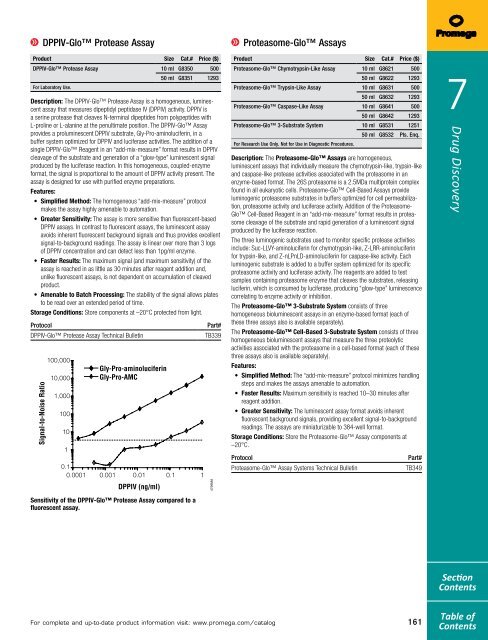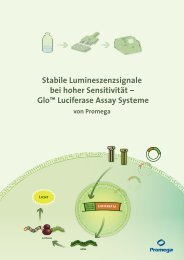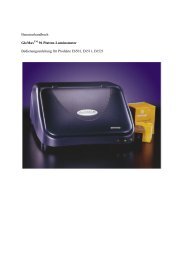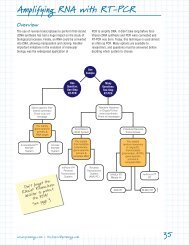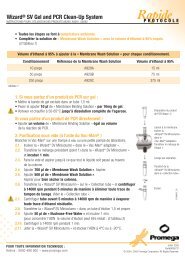2013 Promega catalogue
2013 Promega catalogue
2013 Promega catalogue
Create successful ePaper yourself
Turn your PDF publications into a flip-book with our unique Google optimized e-Paper software.
Cell Signaling<br />
DPPIV-Glo Protease Assay<br />
Product Size Cat.# Price ($)<br />
DPPIV-Glo Protease Assay 10 ml G8350 500<br />
For Laboratory Use.<br />
50 ml G8351 1293<br />
Description: The DPPIV-Glo Protease Assay is a homogeneous, luminescent<br />
assay that measures dipeptidyl peptidase IV (DPPIV) activity. DPPIV is<br />
a serine protease that cleaves N-terminal dipeptides from polypeptides with<br />
L-proline or L-alanine at the penultimate position. The DPPIV-Glo Assay<br />
provides a proluminescent DPPIV substrate, Gly-Pro-aminoluciferin, in a<br />
buffer system optimized for DPPIV and luciferase activities. The addition of a<br />
single DPPIV-Glo Reagent in an “add-mix-measure” format results in DPPIV<br />
cleavage of the substrate and generation of a “glow-type” luminescent signal<br />
produced by the luciferase reaction. In this homogeneous, coupled-enzyme<br />
format, the signal is proportional to the amount of DPPIV activity present. The<br />
assay is designed for use with purified enzyme preparations.<br />
Features:<br />
• Simplified Method: The homogeneous “add-mix-measure” protocol<br />
makes the assay highly amenable to automation.<br />
• Greater Sensitivity: The assay is more sensitive than fluorescent-based<br />
DPPIV assays. In contrast to fluorescent assays, the luminescent assay<br />
avoids inherent fluorescent background signals and thus provides excellent<br />
signal-to-background readings. The assay is linear over more than 3 logs<br />
of DPPIV concentration and can detect less than 1pg/ml enzyme.<br />
• Faster Results: The maximum signal (and maximum sensitivity) of the<br />
assay is reached in as little as 30 minutes after reagent addition and,<br />
unlike fluorescent assays, is not dependent on accumulation of cleaved<br />
product.<br />
• Amenable to Batch Processing: The stability of the signal allows plates<br />
to be read over an extended period of time.<br />
Storage Conditions: Store components at –20°C protected from light.<br />
Protocol<br />
DPPIV-Glo Protease Assay Technical Bulletin<br />
Signal-to-Noise Ratio<br />
100,000<br />
10,000<br />
1,000<br />
100<br />
10<br />
1<br />
Gly-Pro-aminoluciferin<br />
Gly-Pro-AMC<br />
0.1<br />
0.0001 0.001 0.01 0.1 1<br />
DPPIV (ng/ml)<br />
Sensitivity of the DPPIV-Glo Protease Assay compared to a<br />
fluorescent assay.<br />
Part#<br />
TB339<br />
4799MA<br />
Proteasome-Glo Assays<br />
Product Size Cat.# Price ($)<br />
Proteasome-Glo Chymotrypsin-Like Assay 10 ml G8621 500<br />
50 ml G8622 1293<br />
Proteasome-Glo Trypsin-Like Assay 10 ml G8631 500<br />
50 ml G8632 1293<br />
Proteasome-Glo Caspase-Like Assay 10 ml G8641 500<br />
50 ml G8642 1293<br />
Proteasome-Glo 3-Substrate System 10 ml G8531 1251<br />
50 ml G8532 Pls. Enq.<br />
For Research Use Only. Not for Use in Diagnostic Procedures.<br />
Description: The Proteasome-Glo Assays are homogeneous,<br />
luminescent assays that individually measure the chymotrypsin-like, trypsin-like<br />
and caspase-like protease activities associated with the proteasome in an<br />
enzyme-based format. The 26S proteasome is a 2.5MDa multiprotein complex<br />
found in all eukaryotic cells. Proteasome-Glo Cell-Based Assays provide<br />
luminogenic proteasome substrates in buffers optimized for cell permeabilization,<br />
proteasome activity and luciferase activity. Addition of the Proteasome-<br />
Glo Cell-Based Reagent in an “add-mix-measure” format results in proteasome<br />
cleavage of the substrate and rapid generation of a luminescent signal<br />
produced by the luciferase reaction.<br />
The three luminogenic substrates used to monitor specific protease activities<br />
include: Suc-LLVY-aminoluciferin for chymotrypsin-like, Z-LRR-aminoluciferin<br />
for trypsin-like, and Z-nLPnLD-aminoluciferin for caspase-like activity. Each<br />
luminogenic substrate is added to a buffer system optimized for its specific<br />
proteasome activity and luciferase activity. The reagents are added to test<br />
samples containing proteasome enzyme that cleaves the substrates, releasing<br />
luciferin, which is consumed by luciferase, producing “glow-type” luminescence<br />
correlating to enzyme activity or inhibition.<br />
The Proteasome-Glo 3-Substrate System consists of three<br />
homogeneous bioluminescent assays in an enzyme-based format (each of<br />
these three assays also is available separately).<br />
The Proteasome-Glo Cell-Based 3-Substrate System consists of three<br />
homogeneous bioluminescent assays that measure the three proteolytic<br />
activities associated with the proteasome in a cell-based format (each of these<br />
three assays also is available separately).<br />
Features:<br />
• Simplified Method: The “add-mix-measure” protocol minimizes handling<br />
steps and makes the assays amenable to automation.<br />
• Faster Results: Maximum sensitivity is reached 10–30 minutes after<br />
reagent addition.<br />
• Greater Sensitivity: The luminescent assay format avoids inherent<br />
fluorescent background signals, providing excellent signal-to-background<br />
readings. The assays are miniaturizable to 384-well format.<br />
Storage Conditions: Store the Proteasome-Glo Assay components at<br />
–20°C.<br />
Protocol<br />
Proteasome-Glo Assay Systems Technical Bulletin<br />
Part#<br />
TB349<br />
7<br />
Drug Discovery<br />
Section<br />
Contents<br />
For complete and up-to-date product information visit: www.promega.com/catalog<br />
161<br />
Table of<br />
Contents


